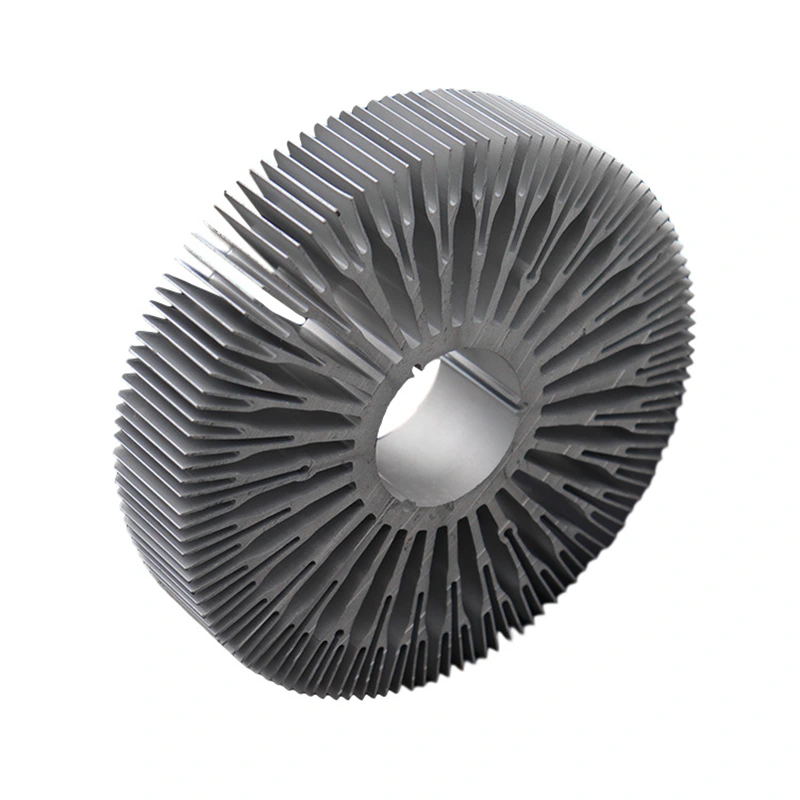Design and Function of Aluminium Heat Sinks
2024-05-22
Aluminum heat sinks are passive cooling devices used to dissipate heat from electronic components, such as CPUs, GPUs, power transistors, and LED lights. They are commonly made from aluminum due to its excellent thermal conductivity, lightweight nature, and cost-effectiveness. Here's an overview of aluminum heat sinks, including their design, function, types, and applications:
Design and Function
1. Fins:
- Heat sinks feature a series of fins or ridges that increase the surface area available for heat dissipation. These fins are usually arranged in a regular pattern to maximize airflow and cooling efficiency.
2. Base Plate:
- The base plate of the heat sink is in direct contact with the heat-generating component (e.g., CPU). It conducts heat away from the component and distributes it to the fins for dissipation.
3. Material:
- Aluminum is the most common material for heat sinks due to its high thermal conductivity and lightweight properties. Other materials like copper or alloys may also be used for specialized applications requiring higher thermal performance.
4. Mounting Mechanism:
- Heat sinks are typically mounted onto the surface of the component using thermal interface materials (e.g., thermal paste) to ensure good thermal contact and minimize thermal resistance.
5. Cooling Mechanism:
- Heat is transferred from the component to the heat sink through conduction, and then dissipated into the surrounding air through convection. Airflow over the fins, either from natural convection or forced air (e.g., fans), enhances heat dissipation.
Types of Aluminum Heat Sinks
1. Extruded Heat Sinks:
- Made by extruding aluminum through a die to create the desired shape. They are cost-effective and versatile, suitable for a wide range of applications.
2. Stamped Heat Sinks:
- Manufactured by stamping aluminum sheets into shape. They are lightweight and often used in low-power applications.
3. Bonded Fin Heat Sinks:
- Consist of aluminum fins bonded to a base plate using adhesive or brazing. They offer high thermal performance and are used in applications with high power densities.
4. Skived Heat Sinks:
- Created by cutting and folding aluminum sheets into shape. They have thin fins with a high aspect ratio, providing excellent thermal performance in compact designs.
Applications
1. Computers and Electronics:
- CPUs, GPUs, voltage regulators, and other electronic components in computers and consumer electronics.
2. LED Lighting:
- High-power LED lights generate heat that needs to be dissipated to maintain performance and longevity.
3. Automotive:
- Power electronics, motor controllers, and LED headlights in vehicles benefit from heat sinks to manage thermal loads.
4. Industrial Machinery:
- Power semiconductors, motor drives, and inverters in industrial equipment often require heat sinks for cooling.
5. Renewable Energy:
- Power electronics in solar inverters and wind turbines utilize heat sinks to dissipate heat generated during operation.
Considerations
1. Size and Shape:
- Heat sink size and shape should be chosen based on the thermal requirements and available space in the application.
2. Thermal Performance:
- The thermal conductivity of the heat sink material, as well as the design of the fins, will affect its cooling efficiency.
3. Mounting:
- Proper mounting and thermal interface materials are crucial for achieving effective heat transfer between the component and the heat sink.
4. Environmental Conditions:
- Consider factors such as temperature, humidity, and vibration levels in the operating environment when selecting a heat sink.
Conclusion
Aluminum heat sinks are essential components in electronic systems and other applications where effective heat dissipation is critical. Their design, material, and mounting play crucial roles in optimizing thermal performance and ensuring the reliable operation of heat-sensitive components. By choosing the right heat sink design and configuration for the application, engineers can effectively manage thermal loads and prolong the lifespan of electronic devices and systems.



